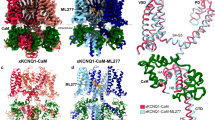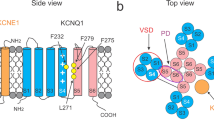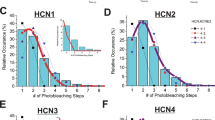Abstract
IN mammalian cardiac cells, a variety of transient or sustained K+ currents contribute to the repolarization of action potentials1. There are two main components of the delayed-rectifier sustained K+ current, IKr (rapid) and IKS (slow)2. IKr is the product of the gene HERG3,4 which is altered in the long-QT syndrome, LQT2 (ref. 5). A channel with properties similar to those of the IKS channel is produced when the cardiac protein IsK is expressed in Xenopus oocytes6–8. However, it is a small protein with a very unusual structure for a cation channel9–15. The LQT1 gene is another gene associated with the LQT syndrome, a disorder that causes sudden death from ventricular arrhythmias16. Here we report the cloning of the full-length mouse KVLQT1 complemen-tary DNA and show that KVLQT1 associates with IsK to form the channel underlying the IKS cardiac current, which is a target of class-Ill anti-arrhythmic drugs and is involved in the LQT1 syndrome.
This is a preview of subscription content, access via your institution
Access options
Subscribe to this journal
Receive 51 print issues and online access
$199.00 per year
only $3.90 per issue
Buy this article
- Purchase on Springer Link
- Instant access to full article PDF
Prices may be subject to local taxes which are calculated during checkout
Similar content being viewed by others
References
Deal, K. K., England, S. K. & Tamkun, M. M. Physiol. Rev. 76, 49–67 (1996).
Sanguinetti, M. C. & Jurkiewicz, N. K. J. Gen. Physiol. 96, 195–215 (1990).
Sanguinetti, M. C., Jiang, C. G., Curran, M. E. & Keating, M. T. Cell 81, 299–307 (1995).
Trudeau, M. C., Warmke, J. W., Ganetzky, B. & Robertson, G. A. Science 269, 92–95 (1995).
Curran, M. E. et al. Cell 80, 795–803 (1995).
Takumi, T., Ohkubo, H. & Nakanishi, S. Science 242, 1042–1045 (1988).
Folander, K. et al. Proc. Natl Acad. Sci. USA 87, 2975–2979 (1990).
Honore, E. et al. EMBO J. 10, 2805–2811 (1991).
Attali, B. et al. Nature 365, 850–852 (1993).
Blumenthal, E. M. & Kaczmarek, L. K. J. Neurosci. 14, 3097–3105 (1994).
Freeman, L. C. & Kass, R. S. Circ. Res. 73, 968–973 (1993).
Hice, R. E. et al. Eur. J. Physiol. 426, 139–145 (1994).
Lesage, F. et al. Recept. Channels 1, 143–152 (1993).
Tzounopoulos, T., Guy, H. R., Durell, S., Adelman, J. P. & Maylie, J. Proc. Natl Acad. Sci. USA 92, 9593–9597 (1995).
Zhang, Z. J. et al. Proc. Natl Acad. Sci. USA 91, 1766–1770 (1994).
Wang, Q. et al. Nature Genet. 12, 17–23 (1996).
Nuss, H. B. & Marban, E. J. Physiol. (Lond.) 479, 265–279 (1994).
Honore, E., Attali, B., Lesage, F., Barhanin, J. & Lazdunski, M. Biochem. Biophys. Res. Commun. 184, 1135–1141 (1992).
Benefraim, I., Shai, Y. & Attali, B. J. Biol. Chem. 271, 8768–8771 (1996).
Attali, B. et al. J. Biol. Chem. 268, 24283–24289 (1993).
Lingueglia, E., Voilley, N., Waldmann, R., Lazdunski, M. & Barbry, P. FEBS Lett. 318, 95–99 (1993).
Guillemare, E. et al. Biochemistry 31, 12463–12468 (1992).
Hamill, O. P., Marty, A., Neher, E., Sakmann, B. & Sigworth, F. J. Pflugers Arch. 391, 85–100 (1981).
Fink, M. et al. J. Biol. Chem. 271, 26341–26348 (1996).
Author information
Authors and Affiliations
Rights and permissions
About this article
Cite this article
Barhanin, J., Lesage, F., Guillemare, E. et al. KvLQT1 and IsK (minK) proteins associate to form the IKS cardiac potassium current. Nature 384, 78–80 (1996). https://doi.org/10.1038/384078a0
Received:
Accepted:
Issue Date:
DOI: https://doi.org/10.1038/384078a0
This article is cited by
-
Clinical and functional characterisation of a recurrent KCNQ1 variant in the Belgian population
Orphanet Journal of Rare Diseases (2023)
-
Ligand activation mechanisms of human KCNQ2 channel
Nature Communications (2023)
-
Computational Study on Effect of KCNQ1 P535T Mutation in a Cardiac Ventricular Tissue
The Journal of Membrane Biology (2023)
-
Gene mutations in comorbidity of epilepsy and arrhythmia
Journal of Neurology (2023)
-
KCNE1 does not shift TMEM16A from a Ca2+ dependent to a voltage dependent Cl- channel and is not expressed in renal proximal tubule
Pflügers Archiv - European Journal of Physiology (2023)
Comments
By submitting a comment you agree to abide by our Terms and Community Guidelines. If you find something abusive or that does not comply with our terms or guidelines please flag it as inappropriate.



